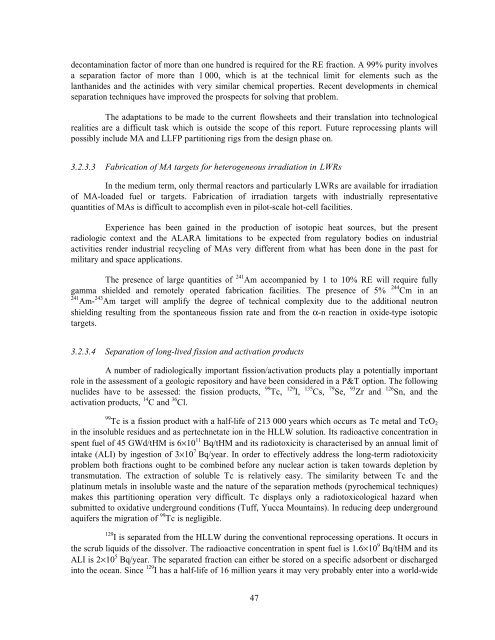COMPLETE DOCUMENT (1862 kb) - OECD Nuclear Energy Agency
COMPLETE DOCUMENT (1862 kb) - OECD Nuclear Energy Agency
COMPLETE DOCUMENT (1862 kb) - OECD Nuclear Energy Agency
Create successful ePaper yourself
Turn your PDF publications into a flip-book with our unique Google optimized e-Paper software.
decontamination factor of more than one hundred is required for the RE fraction. A 99% purity involves<br />
a separation factor of more than 1 000, which is at the technical limit for elements such as the<br />
lanthanides and the actinides with very similar chemical properties. Recent developments in chemical<br />
separation techniques have improved the prospects for solving that problem.<br />
The adaptations to be made to the current flowsheets and their translation into technological<br />
realities are a difficult task which is outside the scope of this report. Future reprocessing plants will<br />
possibly include MA and LLFP partitioning rigs from the design phase on.<br />
3.2.3.3 Fabrication of MA targets for heterogeneous irradiation in LWRs<br />
In the medium term, only thermal reactors and particularly LWRs are available for irradiation<br />
of MA-loaded fuel or targets. Fabrication of irradiation targets with industrially representative<br />
quantities of MAs is difficult to accomplish even in pilot-scale hot-cell facilities.<br />
Experience has been gained in the production of isotopic heat sources, but the present<br />
radiologic context and the ALARA limitations to be expected from regulatory bodies on industrial<br />
activities render industrial recycling of MAs very different from what has been done in the past for<br />
military and space applications.<br />
The presence of large quantities of 241 Am accompanied by 1 to 10% RE will require fully<br />
gamma shielded and remotely operated fabrication facilities. The presence of 5% 244 Cm in an<br />
241 Am- 243 Am target will amplify the degree of technical complexity due to the additional neutron<br />
shielding resulting from the spontaneous fission rate and from the α-n reaction in oxide-type isotopic<br />
targets.<br />
3.2.3.4 Separation of long-lived fission and activation products<br />
A number of radiologically important fission/activation products play a potentially important<br />
role in the assessment of a geologic repository and have been considered in a P&T option. The following<br />
nuclides have to be assessed: the fission products, 99 Tc, 129 I, 135 Cs, 79 Se, 93 Zr and 126 Sn, and the<br />
activation products, 14 C and 36 Cl.<br />
99 Tc is a fission product with a half-life of 213 000 years which occurs as Tc metal and TcO 2<br />
in the insoluble residues and as pertechnetate ion in the HLLW solution. Its radioactive concentration in<br />
spent fuel of 45 GWd/tHM is 6×10 11 Bq/tHM and its radiotoxicity is characterised by an annual limit of<br />
intake (ALI) by ingestion of 3×10 7 Bq/year. In order to effectively address the long-term radiotoxicity<br />
problem both fractions ought to be combined before any nuclear action is taken towards depletion by<br />
transmutation. The extraction of soluble Tc is relatively easy. The similarity between Tc and the<br />
platinum metals in insoluble waste and the nature of the separation methods (pyrochemical techniques)<br />
makes this partitioning operation very difficult. Tc displays only a radiotoxicological hazard when<br />
submitted to oxidative underground conditions (Tuff, Yucca Mountains). In reducing deep underground<br />
aquifers the migration of 99 Tc is negligible.<br />
129 I is separated from the HLLW during the conventional reprocessing operations. It occurs in<br />
the scrub liquids of the dissolver. The radioactive concentration in spent fuel is 1.6×10 9 Bq/tHM and its<br />
ALI is 2×10 5 Bq/year. The separated fraction can either be stored on a specific adsorbent or discharged<br />
into the ocean. Since 129 I has a half-life of 16 million years it may very probably enter into a world-wide<br />
47
















